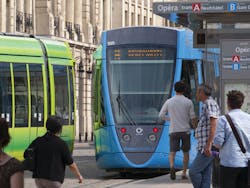Tom Trabon came from a typical background for baby boomers when it came to transportation.
After World War II, streetcar systems across the U.S. began to disappear as transit fell out of favor as more people turned to cars as they fled the cities and moved into the suburbs. Kansas City had one of the largest streetcar systems in the county when it was purchased, then dismantled by automobile manufacturers.
However, Trabon is now chair of the Kansas City Streetcar Authority and he’s now on the verge of helping that city rebuild its streetcar system.
“Kansas City is a car town and it has always been a car town,” he said. Traffic her isn’t terrible, but the demographics of the city are changing and my age bracket — I’m 63 — and the views of those who area 25 years old are a lot different than ours and public transit is very important to them.”
Streetcar systems have seen a resurgence in the past decade as more cities see young professionals bucking the trends of their parents and grandparents by fleeing the suburbs in favor of urban living with access to mass transit. Because of this demand and the economic development potential streetcars bring with them, cities continue to explore and plan systems despite the caustic attitudes towards the systems naysayers have, who claim streetcar — and rail transit for that matter — are outdated machines using 19th Century technology that are nothing more than government “boondoggles” and lack the convenience and freedom offered by car usage.
Kansas City has seen its share of opposition to the $102 million 2.2 mile system in its downtown which passed a voter referendum and is moving forward despite efforts of two downtown property owners who have filed a lawsuit claiming the election was inappropriate. The lawsuit was dismissed by one judge and is now in appeal, which has delayed the issuance of bonds, however, Trabon said work is still moving forward and will continue with the plan of starting work by the end of the year.
Not your grandfather’s streetcar
Jacques Drouin, product manager for Bombardier Transportation North America, said while the streetcar market has essentially be filled in Canada with agencies there focusing more on light rail, but there’s a large interest for the systems in the U.S.
Besides the technology modern streetcars bring with them, Drouin said cities setting up streetcar lines also are asking manufacturers for low-boarding floors in order to meet ADA compliance and they’re also inquiring more about catenary-less systems.
“There’s of course the old streetcars that are still used by some in the U.S. and Canada, and it’s an image people don’t forget,” Drouin said. “But the new ones are very different and very appealing with low-boarding, while 50 or 60 years ago people remember the high boarding…so now it’s a lot easier for people to use, especially handicapped people.”
Often cities getting streetcars don’t have existing rail lines, so Matt Palilla, director of product development for United Streetcar, said that company has worked to make designs easier to prepare for future maintenance.
“We’ve found ways to improve the vehicles so you don’t need extensive tooling for a fleet of 100 vehicles when they may only have seven vehicles,” he said. “That helps make it a little bit easier for the city.”
Drouin said Bombardier’s catenary-less system uses lithium ion batteries and the company recently completed a deal to supply catenary-less streetcars for a project in Nanjing, China, with about 90 percent of the system without catenary lines.
Although lithium ion batteries have gotten a bad rap in recent months due to issues Boeing has had with the units catching fire on their 787 Dreamliner planes, Drouin said Bombardier uses a different type of technology in its lithium ion batteries,
“It’s the safe side of the technology,” he said. “It may contain a little less energy, but it’s safer in its propensity to catch fire as it self-extinguishes itself. We’re confident this is really the way to go.”
Besides the aesthetic advantage catenary-less streetcars hold over the older technology, it also will lessen maintenance costs of the system as wires will no longer need to be replaced.
Despite the advantages a catenary-less system brings, some planners are still a little gun shy with going with the technology given it’s still relatively new.
“The concerns cities have right now with the supercapacitors is it’s an ever changing environment,” said Kyle Keahey, vice president and transit sector market leader for the central division of HNTB. “You’re going to be making a major investment in a technology that in 10 years from now may be obsolete and that’s really the concern they’re wrestling with.”
Guillaume Mehlman, senior vice president for North America for Alstom Transportation Inc., said off-wire powered streetcars have been put in by that company in Dubai, France and other countries across the world. Alstom has seven systems around the world using battery power, third connector and capacitors to run off-wire, with the company working on and eighth wireless system now.
“The technology is mature,” he said. “It’s a reality elsewhere in the world.”
Not just for downtown anymore
Although many cities putting in modern streetcars have opted for a downtown circulator type design, Drouin said they should consider dropping that model in favor of using streetcar lines more like a light rail, similar to the lines in Toronto.
“When used for what they’re meant for, streetcars can be used in a better way than buses because they can transport more people,” he said.
Keahey said expansion of using streetcars there’s a lot of desire by cities to begin using streetcar systems to mimic a light rail system, with some taking a hybrid approach. He said Austin had the idea of starting with a downtown circulator, but once planners began looking it new phases of initial streetcar lines, they see transforming it to more of a line haul function.
“We certainly didn’t see that type of conversation 10 years ago, but dollars became more scarce, so those trying to put in a streetcar, the plan of starting small and then expanding has become very common 10 years later.”
Critics of streetcars have instead pointed to bus rapid transit systems as alternatives to rail transportation as they use buses and therefore don’t require as much infrastructure to implement. Drouin said there’s nothing wrong with BRT lines, however, streetcars provide long-term cost benefits and are also more environmentally friendly given buses run on diesel fuel.
“The streetcar line, the people say it’s more expensive and it’s true, the capital costs to buy a streetcar is more expensive than to buy a bus,” Drouin said. “But streetcars last 30 to 40 years while a bus has to be replaced in 10 years so in a 20 year period, you’ve already replaced it twice with a bus, so it’s a matter of choice and go for the long run and get all of the savings, or do you do it quick. But we think it’s better to invest in the future now.”
Mehlman said Alstom has introduced the Citadis Spirit in Ottawa, which acts as a hybrid between circulator and light rail system that can run up to 65 miles per hour.
“That’s really the type of versatility and flexibility that cities want and the market requires if they want to take a streetcar system and expand it into light rail,” he said. “We have to adapt to those needs and provide those kinds of solutions.”
Still no less controversial
In Milwaukee, city officials are working with HNTB in the design phase of the initial leg of a streetcar system connecting the downtown area to the city’s lower eastside in a fight to build the line, which spans back well over a decade with city leaders butting heads with suburban leaders who have tried to stop the project at all costs despite federal money that has sat dormant for years allotted to such a project.
Wisconsin Gov. Scott Walker has been staunchly opposed to the streetcar project. And a Republican lawmaker whose district represents mostly the suburbs outside of the city and Milwaukee County has already stated he plans to draft legislation that would not allow for the cost of utility relocation for streetcar projects to be passed onto rate payers in an effort to try and kill the city’s project.
Initial estimates to move gas and electric utilities were estimated at roughly $50 million, however, Milwaukee city engineer Jeff Polenske said as the planning process has moved forward, that number is likely to come way down.
“We’re going through the process of working with those utilities to identify their concerns and hopefully creatively address and minimize those concerns in the design phase and that never gets played out in the public,” he said. “The public simply doesn’t understand the process. When the numbers that come out for some of the bigger freeway projects that happen within the city, there are estimates of hundreds of millions of dollars of utility costs at the front end, but then they came down to $10 to $20 million in the end. Yeah, it’s still a big impact, but not nearly as much as the utility cost estimate at the beginning.”
The city of Cincinnati recently completed bidding for work on its proposed $125.4 million 3.6 mile streetcar line, however, after receiving the bids, the project is now expected to run $22.7 million over budget. The revelation means Cincinnati leaders will need to decide if they want to continue the project and find extra funds, or end it now, but planners have already whittled the overrun costs down to about $17 million.
“One of the problems is we underestimated the amount of staging and how much staging would need to take place to move the project across nearly a 4 mile path,” said Meg Olberding, director of communication for the city of Cincinnati. “It was a much different kind of construction bigger than we anticipated, but the bidders saw that basically multiple teardowns and setups were needed that we had not anticipated.”
David Johnson, co-founder of Streetcar Neighbors, which advocates in favor of the Kansas City streetcar, said he ran the “ground game” for the election in that city where voters gave a slim approval to moving forward on the project.
Unlike other cities where streetcar projects have become political footballs, Johnson said the Kansas City Common Council has been moving forward with unanimous votes on the project, which helped it move forward without the friction of political gridlock.
“The interesting thing about ours is we had an election where a yes vote was a yes to support this, while Milwaukee and Cincinnati didn’t,” he said. “I don’t know if that would have helped them and I’m not of the mind that a city needs to go out and get voter approval for everything because that’s what representative government is for, but yeah, it’s different here.”
To streetcars go the spoils
Where planners and politicians have gotten past the political jockeying and naysayers, the payoffs have abound.
In 2003, Sound Transit began operation of Tacoma Link, a 1.6 mile, five stop streetcar line through the downtown area running from the city’s theater district to the Tacoma Dome. Although service began slowly, ridership began to grow throughout the years and in 2012, the line carried more than 1 million people.
And the line has become so popular a sixth stop was even added in 2011.
“Commerce Street has very, very high use,” said Robert Blackburn, manager of Tacoma Link. “With the University of Washington, it connected to their downtown campuses and during the nonpeak hours, ridership is almost that of peak hours.”
Kimberly Reason, public information officer for Sound Transit said the agency is studying corridors in which to expand Tacoma Link. The proposed $150 million expansion is being funded in part by an approved 2008 referendum, federal grants, and public and private partnerships.
“To say people are fired up is an understatement,” she said. “Tacoma Link has become the fundamental spine of the transit system in the city of Tacoma and helped to further development of the city.”
Although the shovels haven’t hit the ground yet in Kansas City, Trabon said there’s already interest in new development along the corridor where the streetcar line will run and studies are already underway to expand the system in the future. In fact, he said the suburb of North Kansas City has even helped finance one of the studies in the hope it can have the streetcar expanded into that community in the future.
“There’s a lot of enthusiasm here and we’re hearing of some developments activities in some of the areas, but I’m hoping we’ll get some announcements soon rather than people telling me they’re working with people who want to move their company here because one of the reasons I’ve been told is to be along the streetcar route,” he said. “This type of development has happened in other places when they put in a streetcar as you know and we’re hopeful the same thing will happen for us.”

Joe Petrie | Associate Editor
I came to Mass Transit in 2013 after spending seven years on the daily newsbeat in southeastern Wisconsin.
Based in Milwaukee, I worked as a daily newspaper reporter with the Waukesha Freeman from 2006-2011, where I covered education, county and state government. I went on to cover courts for Patch.com, where I was the main courts reporter in the Metro Milwaukee cluster of websites.
I’ve won multiple awards during the course of my career and have covered some of the biggest political events in the past decade and have appeared on national programs.
Having covered local government and social issues, I discovered the importance of transit and the impact it can have on communities when implemented, supported and funded.




